
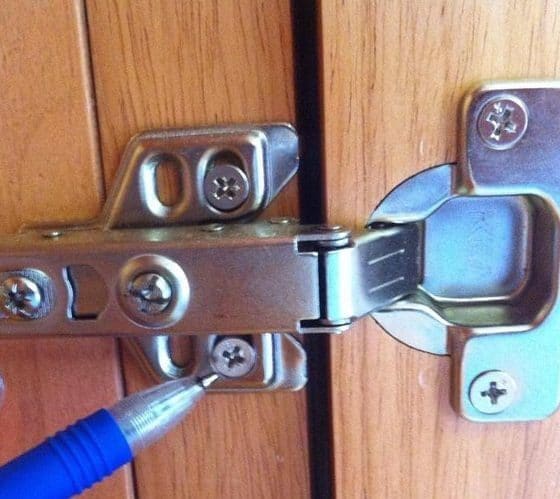
rsz 10adjust alignment cabinet doorsw1456
Cabinet Hinges Types Guide: Different Types of Hinges
Hinges are an essential component of cupboards, gates, window shutters, lids, and doors. They aren’t just important for the proper functioning of your doors and cupboards but also for their appearance. Cabinet hinges can be concealed or lift-off, right-handed or left-handed. They can come in stainless steel, brass, and other materials. There are so many choices of hinges available in the market that choosing the right one can make you come unhinged (pun intended).
This blog helps you choose the right hinge without going through a lot of hassle. We have listed the different types of hinges and their uses based on their structure and application. This way you can easily narrow down your options and choose the hinge that is right for your cabinets. Enjoy!
Table of Contents
What is a Cabinet Hinge?
Hinges are simple mechanical devices that are used to connect two parts together while still maintaining their movement. The two parts connected with the hinge can rotate relative to each other around a fixed axis. Cabinet hinges are known as the “the tireless soldiers of kitchen cabinet hardware” because they stand the test of time and use.
Anatomy of a Traditional Cabinet Hinge
A single hinge is made up of different movable parts that are essential to its function. Cabinet hinges are available in many different kinds of configurations but all types of hinges have four essential components.
Here is a look at the anatomy of a standard cabinet hinge.
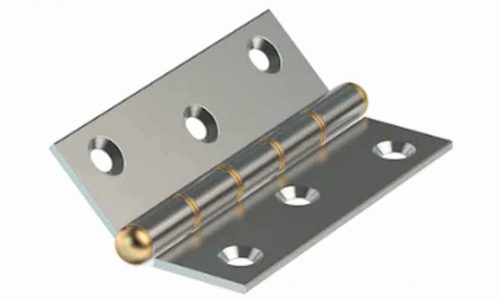
Frame Wing: Part of the hinge that connects to the cabinet frame. Also called the immobile plate or passive leaf.
Door Wing: Part of the hinge that connects to the cabinet door. Also called the moving plate or active leaf.
Knuckle: Part of the hinge that connects the frame winge and door wing. It is also responsible for allowing easy rotation. A leaf or wing is called female if it has an odd number of knuckles and male if it has an even number of knuckles.
Pin: Part of the hinge that holds all components together. Also called a rod or shaft.
European-Style Hinges
European style hinges are commonly used in modern, minimalistic settings. These hinges have a slightly different construction as compared to traditional hinges. Here is a look at Euro-style hinge components.

Cup Plate: Part of the hinge that mounts to the door.
Mounting Plate: Part of the hinge that mounts to the frame.
Screws: Part of the hinge that can be used for height and depth adjustments.
Different Types of Cabinet Hinges
Now that you have an idea of the basic structure of a cabinet hinge, let’s dive into the different types of hinges you’ll find in the market. We’ve divided the types based on their design/construction and ways to install them so you can make an educated decision.
The following are types of cabinet hinges based on the way they are structured or designed.
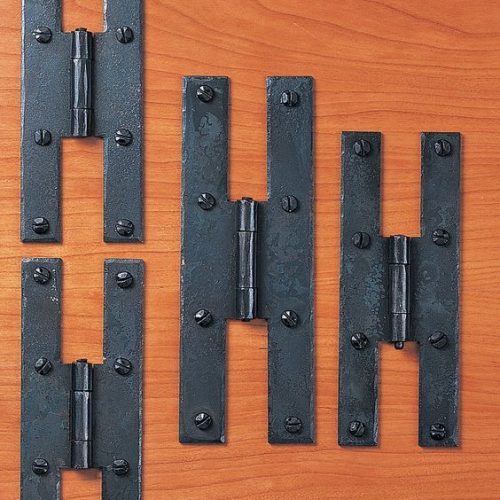
“H” & “HL” Hinges
These are the most common types of hinges found in the market. They are called ‘H’ and ‘HL’ hinges because of the way they are shaped. You can find these hinges in both plain and decorative styles. These hinges are usually installed on the surface of cabinets and are non-adjustable.
Strap Hinges
Strap hinges are a type of decorative hinge that is usually used on heavy doors and gates. These hinges mount on the outside of the door and are non-adjustable.
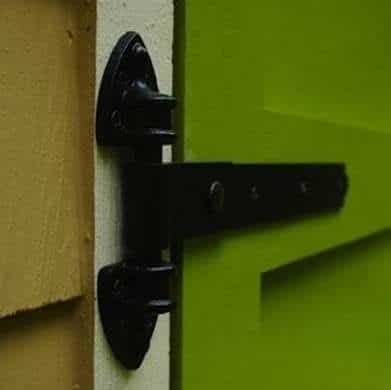
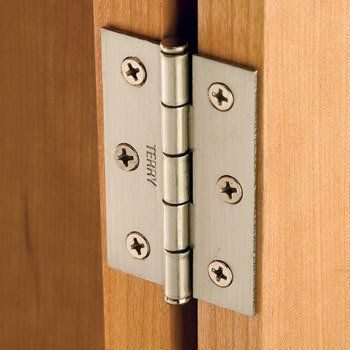
Butt Hinges
Butt hinges are also very common in the cabinetry world. These hinges resemble traditional style cabinet hinges with two leaves connected by knuckles and pin. Most butt hinges are recessed or mortised so you have to cut out the edge of the door and frame to install them. However, you can also find self-mortised butt hinges in the market. These hinges are adjustable and available in a number of attractive finishes and styles.
Barrel Hinges
Barrel hinges get their name from their inventor. These hinges are mortised into the door edges and are completely concealed when the door is closed. Barrel hinges are very strong and are usually installed on cabinet doors, folding doors, and shutters. These might be a little difficult to install though so it’s a good idea to get professional help.
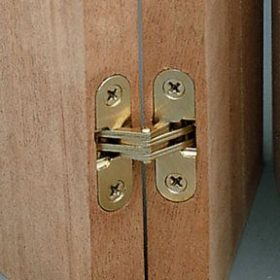
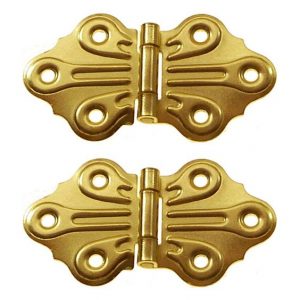
Butterfly or Case Hinges
As the name suggests, butterfly or case hinges are mainly used for decorative purposes. They have ornate designs are usually installed on the surface of the door so they are visible even when the door is closed.
Continuous Hinges
Continuous hinges are named so because they are long, narrow, and a single hinge runs along the entire interior length of the cabinet. These are also called piano hinges and can be installed both on the interior and exterior of the door depending upon your preference.
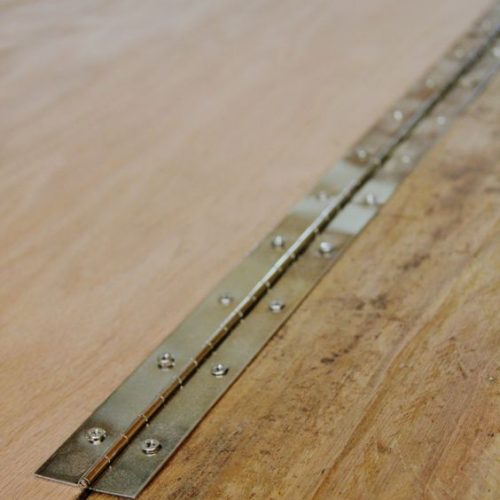
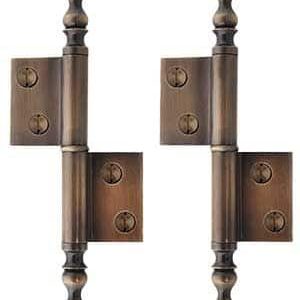
Flag Hinges
Flag hinges are a type of lift-off hinge that comes with a fixed pin inserted in one of the rectangular leaves. This allows for 360-degree rotation and easy dismantling of the hinge whenever the cabinet door needs to be repaired or replaced.
Four Bar Hinges
Four bar hinges have multiple bars that allow the attached doors to move outwards as it is opened to avoid hitting the edge of the frame. These hinges are usually used with projected and parallel opening doors, windows, and panels. They are also called multi-bar hinges.
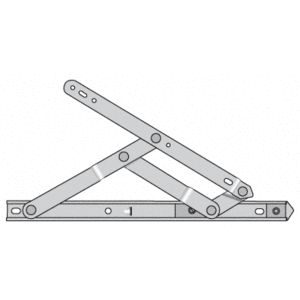
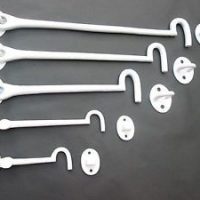
Hook and Eye Hinges
Hook and eye hinges are another type of decorative hinge that can be installed on the exterior of doors and gates. These hinges comprise of a longe L-shaped hook and an eye-shaped loop.
Spring Hinges
Spring hinges feature an additional spring component that allows you to keep the door in an open or closed position. These are usually concealed hinges that are installed inside the door. Double action spring hinges can be used for movement in both directions.
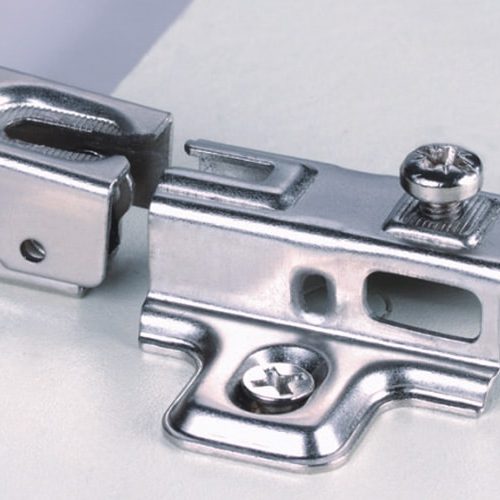
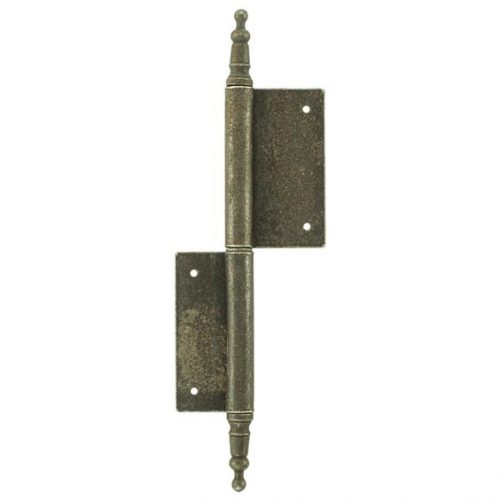
Fiche Hinges
Fiche hinges are more commonly found in France. They feature long hinges that run across the length of the door and are usually visible when the door is closed. They also have rods that are inserted into the cabinet door and the cylindrical hinges have to be mortised to the cabinet frame.
Here are some types of hinges based on how they are installed on the cabinet frames.
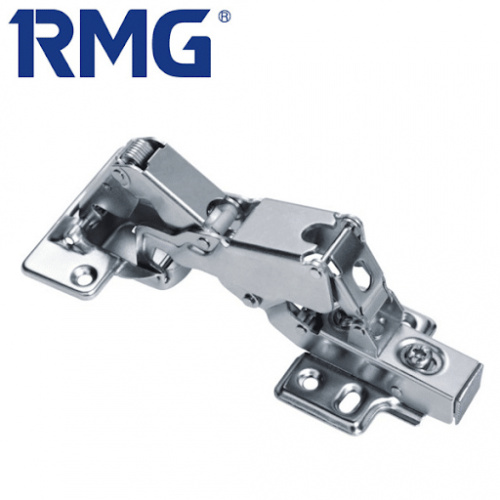
Wrap Around Hinges
As the name suggests, wrap-around hinges have a leaf that attaches to the back of the door and another leaf that wraps around the cabinet frame and is connected to the inside of the cabinet. These hinges provide a lot of strength and stability to cabinet doors.
Face Frame Hinges
Face frame hinges are designed for framed cabinets with partial or full overlay. These hinges attach to the door and the face frame of the cabinet and allow easy movement. These hinges are usually concealed and can only be seen when the cabinet door is opened.
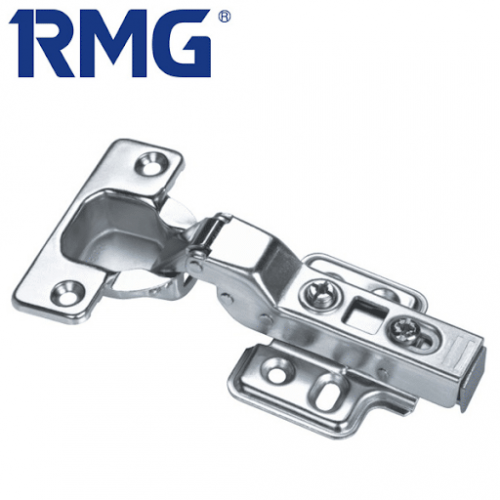
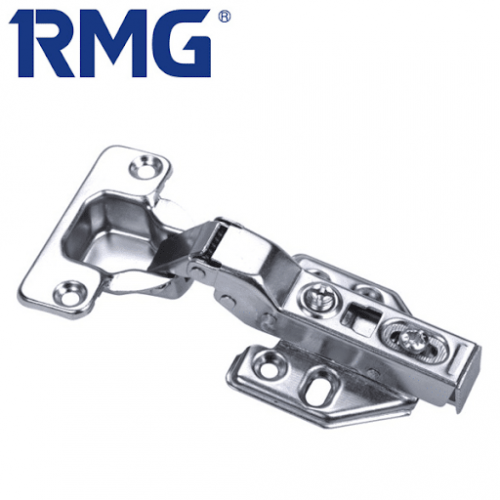
Surface Mount Hinges
Surface mount hinges are mounted completely behind the door of the cabinet. These are often adjustable and self-mortise and are only partially visible even when the cabinet door is open.
Inset Hinges
Inset hinges are semi-concealed hinges installed on inset cabinet doors. The frame wing of these hinges is visible when the door is closed while the door wing remains concealed behind the door and extends into the frame cavity.
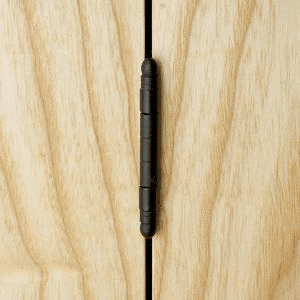
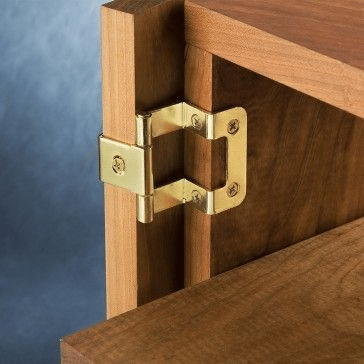
Overlay Hinges
Overlay hinges are installed on full or partial overlay cabinet doors. The frame wing of the hinge wraps two sides of the frame allowing the door to overlap the frame of the cabinet.
Reverse Bevel Hinges
Reverse bevel hinges work in the same way as overlay hinges where the frame wing wraps the two sides of the frame. In addition to that, the reverse barrel hinge has a door wing that accepts doors with a mounting edge sloping inward.
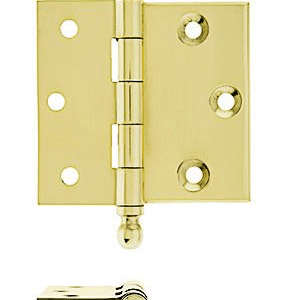
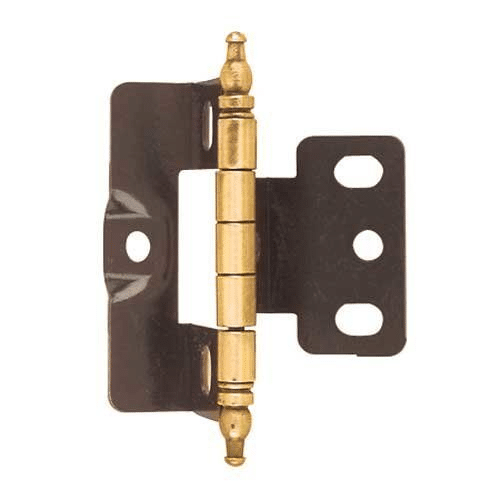
Flush/Full Inset Hinges
Flush inset hinges are installed between the cabinet door and frame in such a way that only the knuckle of the hinge is visible. One wing of the hinge is attached to the inside of the cabinet door while the other is attached to the inside of the frame.
Self-Mortise Hinges
Self-mortise hinges are usually installed on inset cabinets and are self-mortise. Since you can see some parts of the hinge when the cabinet door is closed, these hinges come with decorative finials. They need to be installed by a professional because if the screws are jutting out even a little bit the hinge won’t close properly.
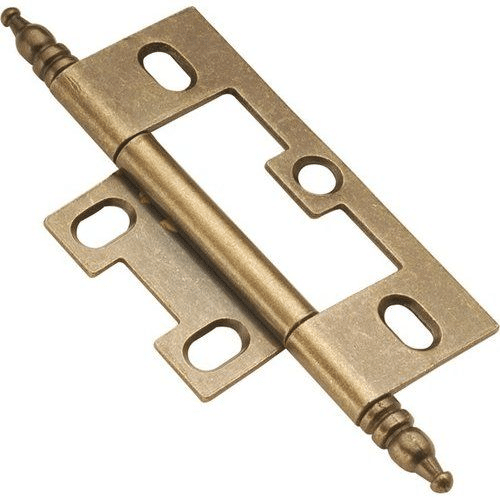
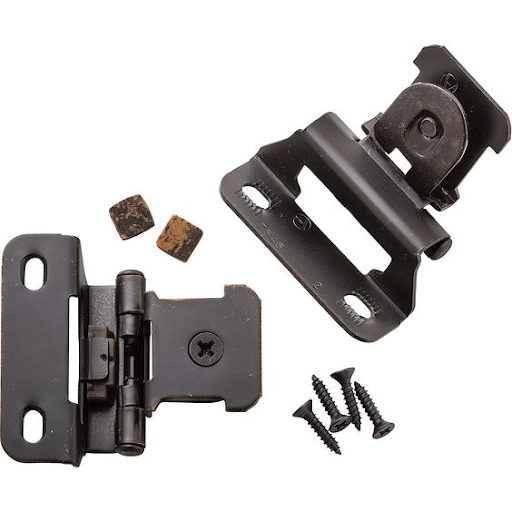
Demountable Hinges
Demountable hinges allow you to remove the cabinet door for repairs or replacement. They come in both single and double demountable configurations. Single demountable hinges can be installed on the face of the cabinet with screws while double hinges have an extra slot that attaches to the edge of the door.
Concealed Hinges
Concealed hinges, as the name suggests, are fully concealed inside the frame of the cabinet door. They are only visible once the cabinet door is opened and are suitable for modern, minimalistic cabinet designs. These are also called cup hinges or European-style hinges.
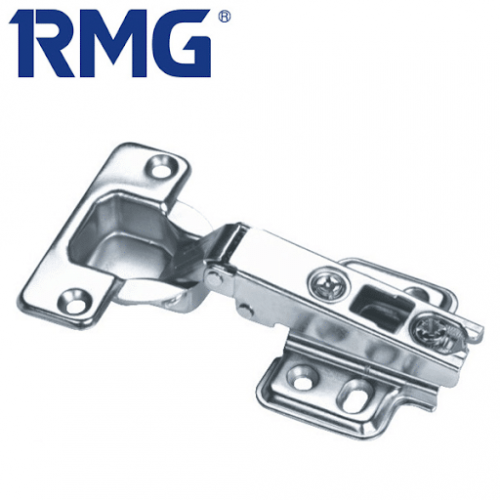
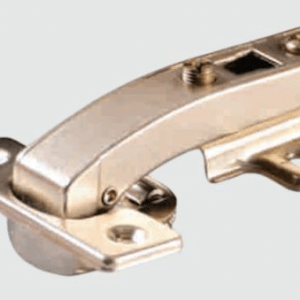
Blind Corner Hinges
Blind corner hinges are designed for blind corner inset doors that are installed flush with the cabinet panel. These hinges are designed to save space so it is much shorter than normal hinges.
Soft Close Hinges
As the name suggests, these hinges allow the cabinet door to be closed softly no matter how hard the door is slammed. They are easy to assemble, work on existing mounting plates, and are adjustable. However, they need to be installed by a professional as they need precise adjustments.
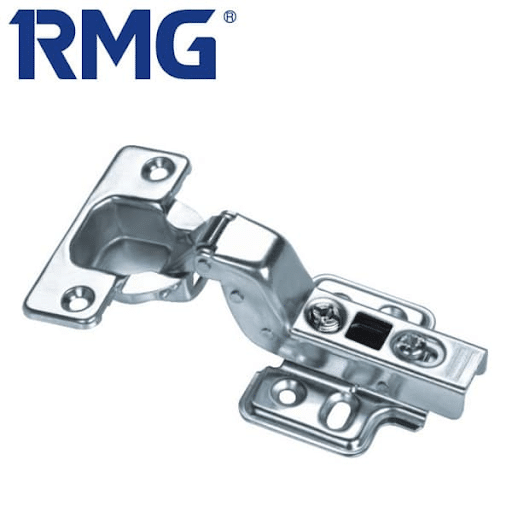
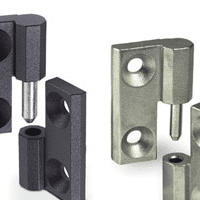
Screw-In/Lift-Off Hinges
Liftoff hinges are a special type of cabinet hinge where the two leaves of the hinge can separated easily. This comes in handy when you want to remove a door and are normally used for heavy and large doors or windows. They are also called take-apart, slip-joint, or pivot hinges and are available in a number of sizes and shapes.
FAQs About Cabinet Hinges
1. What is the difference between hinge and pin connection?
A pin connection is used in joints that need to be able to rotate while a hinge connection is used for greater stability.
2. What is a full overlay cabinet hinge connection?
Full overlay cabinets usually feature a ¾ inch frame on all sides. Full overlay hinges are used for connecting such cabinets.
3. How many hinges does a cabinet door need?
The exact number of hinges needed will depend on the size and height of your cabinet door. Normally 4-5 hinges are enough to connect a single door.
4. How to measure door hinges?
Door hinges are usually measured from top to bottom and side to side. You can use a tape measure to do this easily. Learn more about this here.
5. How to install a hinge?
How you install a hinge depends on the type of hinge you are using and the location of your cabinets. Most hinges can be installed by laypeople while some require professional help. Learn more here.
6. How to measure cabinet hinges?
You can measure cabinet hinges much like the same way you measure door hinges and wardrobe hinges. Follow this tutorial for more information.
7. What size hinges do I need for a door?
The size of the hinge will depend on the size and weight of the door. Normally residential doors need hinges sized 3-1/2″ x 3-1/2″.
8. Which are better frameless or framed cabinets?
Both types of cabinets have their own list of pros and cons. Framed cabinets are a more traditional and dated style while frameless cabinets are more modern. Learn more about them here.
Conclusion
Cabinet hinges are an important part of installing any cabinet door. They are used both for functional and decorative purposes. With so many options available in the market, from concealed hinges to corner hinges, it can be confusing to choose the right one for your needs. Hopefully, this list helped you narrow down your options.
If you are interested in drawer slides, please also check out our catalogs for under-mount drawer slides, side mount slides, full extension slides, and telescopic extensions slides. If you need more help reach out to us today.
RMGHardware is a professional cabinet hinge manufacturer who works closely with various well-known furniture brands, check out our blogs for tips and tricks around furniture hardware! Or contact us if you need help with sourcing hinges.